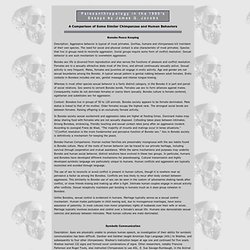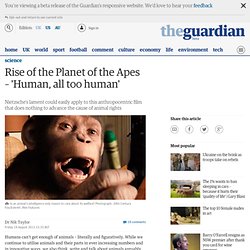

Chimps filmed shaking their head to 'say no' Just say no Bonobos have been filmed appearing to 'say no' by shaking their heads, report scientists.

On a number of occasions, bonobos were filmed using side to side head movements to prevent others from doing something they did not want them to do. In one film a mother is seen shaking her head to stop her infant playing with its food. This may reflect an early precursor to head-shaking behaviour amongst humans in one of our closest relatives. The study has been published in the journal Primates. Chimpanzee Technology & Human Evolution. For a long time, it was a popular conceit that humans alone could produce tools and technology -- it was once regarded as something that defined humanity.

Jane Goodall's research dispelled that myth nearly 50 years ago and since then we've not only found more evidence of tool use among primates, but ever more complicated technology that is passed down among individuals within groups. In fact, so much is being discovered that we may have to seriously reconsider some things about the nature of humanity. Researchers use the term "tool kits" to describe the repertoire of tools used habitually by a group of chimpanzees.
The tool kits of most chimpanzee populations consist of about 20 types of tools, which arc used for various functions in daily life, including subsistence, sociality, sex, and self-maintenance. Chimpanzees consider their audience when communicating. 29 December 2011Last updated at 17:01 By Victoria Gill Science reporter, BBC Nature The chimps made soft "hoo" sounds to warn individuals that had not seen the threat Chimpanzees appear to consider who they are "talking to" before they call out.
Researchers found that wild chimps that spotted a poisonous snake were more likely to make their "alert call" in the presence of a chimp that had not seen the threat. This indicates that the animals "understand the mindset" of others. The insight into the primates' remarkable intelligence will be published in the journal Current Biology. A Comparison of Some Similar Chimpanzee and Human Behaviors. Bonobo Peace Keeping Description: Aggressive behavior is typical of most primates.

Gorillas, humans and chimpanzees kill members of their own species. The need for social and physical contact is also characteristic of most primates. Species that live in groups need to reconcile aggression. Brigitte Bardot, immigration and the rights of apes. Recently, the Spanish Parliament decided to go forward with a project that recognizes basic rights for great apes — i.e., chimpanzees, gorillas, and orangutans.

The idea was inspired on the so-called Great Apes Project, a non-governmental organization that “demand[s] the extension of the community of equals to include all great apes: human beings, chimpanzees, bonobos, gorillas and orangutans.” Essentially, what the Spanish politicians want is to recognize the rights to life, freedom and protection against torture for great apes.
We sit near people who look like us. The next time you're in an audience, turn to the person sat next to you and take a good look.

That's what you look like, that is. Scary eh? Sean Mackinnon and his research team have shown that people sit next to people who resemble themselves. The effect is more than just people of the same sex or ethnicity tending to aggregate - a phenomenon well documented by earlier research. The new finding could help explain why it is that people so often resemble physically their friends and romantic partners (known as "homophily") - if physically similar people choose to sit near each other, they will have more opportunities to forge friendships and romances. Mackinnon's team first noted the seating positions of hundreds of different students in a 31-seat computer lab 21 times over 3 months, and whether or not they were wearing glasses - a simple proxy for physical similarity.
Similar Apes Sit Together.mp4. Birds of a Feather Sit Together: Physical Similarity Predicts Seating Choice. Across four studies, people sat (or reported they would sit) closer to physically similar others.

Study 1 revealed significant aggregation in seating patterns on two easily observed characteristics: glasses wearing and sex. Study 2 replicated this finding with a wider variety of physical traits: race, sex, glasses wearing, hair length, and hair color. The overall tendency for people to sit beside physically similar others remained significant when controlling for sex and race, suggesting people aggregate on physical dimensions other than broad social categories. Study 3 conceptually replicated these results in a laboratory setting. Do we like people more if they move the way we do.
Rise of the Planet of the Apes – 'Human, all too human' Humans can't get enough of animals – literally and figuratively.

While we continue to utilise animals and their parts in ever increasing numbers and in innovative ways, we also think, write and talk about animals arguably more than ever before. There is even a new, cross-disciplinary field of research, Human-Animal Studies. Rise of the Apes via Miracle Grow. This is a Freakonomics guest post by Mark Changizi, an evolutionary neurobiologist, and Director of Human Cognition at 2AI.

His new book Harnessed explores the evolutionary origins of language and music. Rise of the Apes via Miracle Grow By Mark Changizi Add Miracle Grow to your tomato plants and you get tomatoes. Big tomatoes, but still tomatoes. Could “Rise of the Apes” science really happen? « …And Eve Knew Snake. Could “Rise of the Apes” science really happen?

Nature magazine published a report last year suggesting that non-human primates with sections of human DNA implanted into their genomes at the embryonic stage—through a process called transgenics—might develop enough self-awareness “to appreciate the ways their lives are circumscribed, and to suffer, albeit immeasurably, in the full psychological sense of that term.”
“That’s the ethical concern: that we would produce a creature,” says bioethicist Dr. Beware 'Planet of the Apes' experiments that could create sci-fi nightmare. By David Derbyshire Updated: 14:39 GMT, 22 July 2011 It sounds like something from a Hollywood science fiction film: a race that is half human, half ape.

But leading scientists are today demanding tough new rules to prevent the nightmare scenario becoming a reality. The Science of 'Planet of the Apes': Could Simians Get Scary Smart? - Betsy Morais - Entertainment. Is the film plausible? Kinda sorta, say experts. 20th Century Fox There's only about 1.2 percent of genetic difference between human beings and chimpanzees. Going ape about human rights. Are monkeys people, too? By Lita Cosner 9 July 2008 Photo stock.xchng The environmental committee in the Spanish parliament recently passed a resolution giving apes the right to life and freedom. Project GAP. Great Ape Project. The Great Ape Project (GAP), founded in 1993, is an international organization of primatologists, anthropologists, ethicists, and others who advocate a United Nations Declaration of the Rights of Great Apes that would confer basic legal rights on non-human great apes: chimpanzees, bonobos, gorillas, and orangutans.
The rights suggested are the right to life, the protection of individual liberty, and the prohibition of torture. The organization also monitors individual great ape activity in the United States through a census program. Spanish parliament approves 'human rights' for apes. Great apes should have the right to life and freedom, according to a resolution passed in the Spanish parliament, in what could become landmark legislation to enshrine human rights for chimpanzees, gorillas, orang-utans and bonobos. The environmental committee in the Spanish parliament has approved resolutions urging the country to comply with the Great Apes Project, founded in 1993, which argues that "non-human hominids" should enjoy the right to life, freedom and not to be tortured.
In Spain, Human Rights for Apes. Chimps: Not Human, But Are They People? As a population of West African chimpanzees dwindles to critically endangered levels, scientists are calling for a definition of personhood that includes our close evolutionary cousins.